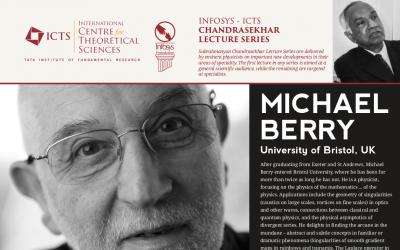Lecture 1: Monday 11 June, 16:00 to 17:00
Title : Nature’s optics and our understanding of light
Abstract : Optical phenomena visible to everyone abundantly illustrate important ideas in science and mathematics. The phenomena considered include rainbows, sparkling reflections on water, green flashes, earthlight on the moon, glories, daylight, crystals, and the squint moon. The concepts include refraction, wave interference, numerical experiments, asymptotics, Regge poles, polarization singularities, conical intersections, and visual illusions.
Lecture 2: Tuesday 12 June, 16:00 to 17:00
Title : Superoscillations (faster than Fourier) (p)revisited: vorticulture, noise, fractals
Abstract : Band-limited functions can oscillate arbitrarily faster than their fastest Fourier component over arbitrarily long intervals: they can ‘superoscillate’. In physics, this mathematical phenomenon is associated with almost-destructive interference, and occurs near phase singularities in optics and on the world’s ocean tides; and it is associated with quantum weak measurements. Where superoscillations occur, functions are exponentially weak and vulnerable to noise. They are an unexpectedly compact way of representing fractals. Superoscillations in red light can escape as gamma radiation.
Lecture 3: Wednesday 13 June, 16:00 to 17:00
Title : Optical curl forces and beyond
Abstract : A physical example of a force that depends on position but is not derivable from a potential, that is, a nonconservative force with non-zero curl, is the force on a dielectric particle in an optical field. The resulting dynamics need not be Hamiltonian or Lagrangian, yet is non-dissipative, with unfamiliar chaotic dynamics. Noether’s theorem does not apply, so the link between symmetries and conservation laws is broken. Although unambiguous in optics, the physical existence of curl forces has been controversial among engineers. Motion under curl forces near optical vortices can be understood in detail, and the full series of ‘superadiabatic’ correction forces derived, leading to an exact slow manifold in which fast (internal) and slow (external) motion of the particle is separated. These classical optical forces have quantum effects.
This lecture series is part of Non-Hermitian Physics - PHHQP XVIII


